BIRDS
One of the best and most rewarding hobbies you can have. West Dunbartonshire has a wide variety of native, visiting and feral species. Only a few are highlighted here.
As with the other sections, this website is not authoritive, but aims to encourage you look about you. Useful sources for bird identification are provided below here and below each specific section.
So get out there twitching and become a twitcher.
Huh!
The following, taken from the BirdSpot website explains :
A twitcher is someone who goes to great lengths to view new bird species. Whereas most bird watchers will be content with spotting birds on their local patch or anything they come across while out in the field or on their travels, twitchers actively hunt down birds, usually to add to their life list.
For some twitchers, their pursuit can turn into an obsession on par with an Olympic sport, and can involve extensive travel, dedicated monitoring of birding hotspots, rare bird alerts, apps, and websites, and networking with other twitchers. Some twitchers have even been known to charter aeroplanes to achieve their goals. Hardcore twitching can ruin friendships, marriages, employment prospects, and drain one’s bank account.
Oh, well. You don't have to make it an obsession. Enjoying the birds around you is great too. Even LBJs. (A term often used when referring to any small brown bird that is too difficult to identify. Ie Little Brown Job).
In fact the less obsessive you are while calmly enjoying the birds around you the better. It is relaxing for you. And the birds.
On the other hand, if you take this study up professionally, you will become an ornithologist.
Birds move around an area; some even migrating vast distances. Their distribution depends on many factors such as climate changes, food availability or persecution and disease, If you want to find out more, it is is suggested that you look at the British Trust for Ornithology, BTO, website noted below.
The eBird website gives a very comprehensive checklist for birds within West Dunbartonshire. See the link below. This includes the locations that they have been seen.
Most of the birds in this area can be found all around us. You just have to find the right environment first. But a good place to visit is the RSPB Bird Reserve at Loch Lomond. RSPB LOCH LOMOND BIRD RESERVE ///songbirds.appendix.cowboy This is off the old Military Road which runs beyond Gartocharn in the direction of Loch Lomond. Note that there is also a road down the lochside and the Loch Lomond Nature Reserve. ///luggage.disco.fresh This is right at the watersedge with a rather pleasant short walk. You can see various water birds - depending on the season and time of day.
A great way to enjoy birds is to do so whie enjoying a good walk. The ALL TRAILS website link below suggests some good birdwatching locations and routes.
The RSPB has an excellent website that can be very useful for identifying geese in West Dunbartonshire. Many migrate. Geese from Greenland, Svalbard and Iceland visit Scotland in internationally important numbers every winter. Large numbers in a field can be an amazing spectacle. But bad news for farmers. The Nature Scot website gives advice on managing them.
Anyway here in West Dunbartonshire with a less crop based agriculture than elsewhere we can simply enjoy them.
The main types that we encounter are the Barnacle Goose, the Canada Goose and the Greylag Goose.
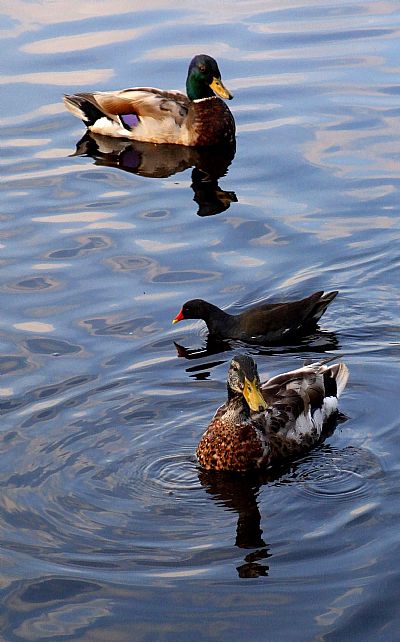
A moorhen darts between Mr and Mrs Mallard.
PREDATORS
Each spring we get excited about seeing broods of new fledglings. Ducklings take to the water early in life and so can be easily seen. Some broods, such as of mallard, can be large, but families with 5 or 6 are more common. Very large flotillas may include "creches" that have "co-opted" the young of other ducks; the ducklings simply don't know any better. Swans can also have 5 or 6 young, but some may have double that. The young swans grow quickly and instill great excitement amongst us humans, but over the year, you may notice the numbers decline.
Predators are varied.
Mallard mums and their young are very well camouflaged, yet other birds such as herons, crows and magpies may take them or simply steal their eggs. Foxes too can take larger birds as can animals such as pine martins, which have been reported from within West Dunbartonshire.
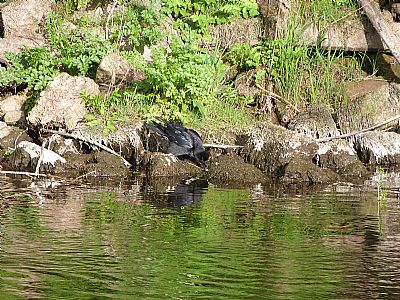
Here a carrion crow eats a stolen egg on the banks of the Leven in May. It had disturbed both a moorhen and a mallard who simultaneously fought back, but then gave in.
PHOTOGRAPHING BIRDS
All of the photos on this website have been taken with inexpensive cameras. You do not need anything fancy. Just remember a few things.
- Birds are usually moving so you need a quick shutter setting. If you rely on an auto setting, then you will also need good light. Try panning as the birds move.
- Birds, at least the more unusual ones will be at some distance. Digital zoom uses the camera's own app to enlarge the image. Optical zoom means that the lens itself magnifies the scene. The former depends on the pixels meaning that if you enlarge an image taken solely with it, it will appear fuzzy with pixels. An image taken with optical zoom ensures better focus. But also remember that any movement on your own part will be exagerated.
Your phone camera is likely to be quite good for nearby birds such as swans and ducks and perhaps pheasants. But it will have a limit to how sharp the image will be when enlarged. Some of the images used here were taken with bridge cameras with zoom capacity of the equivalent of about 3oomm of a more expensive zoom lense attached to a DLSR camera (single-lens reflex camera). And these can often be bought very cheaply online reconditioned from reputable outlets (eg +-£80, that is less than a smart phone). Of course if you can afford some fancy kit, your range of options is much greater - if you learn how to use it properly.
The next thing that should consider is a reasonable photo editing programme. At the very basic level you need to be able to trim the photo down to just the main subject, sharpen the image a bit and adjust the lighting and/or colour. There are many options out there. Favourites include ZoomBrowser produced by Canon and excellent for basic editing AND filing and PhotoShop produced by Adobe. The images on this website were edited using a combination of ZoomBrowsing and Serif PhotoPlus which is similar to PhotoShop. Free downloads are available online.
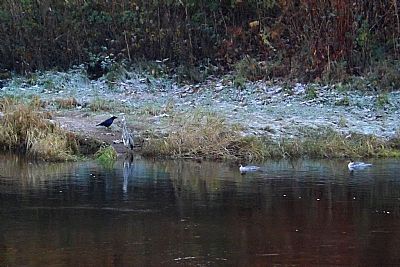
Getting good portraits of birds is one thing. Even if you do not have much of a zoom on your camera or phone, you can record relationships of birds - which form large flocks, which come to the bird feeder, which don't get on together. On this cold winter morning some carrion crows were entertaining themselves by tormenting a heron. Sometimes they may see this as a real threat to their young, but on this occasson were probably just bored. (Crows get bored easily). Some gulls had joined in, bit flew off. Two goosanders paddle up to see what all the fuss is about. Can you see the grey heron agains the frosty grey riverbank.
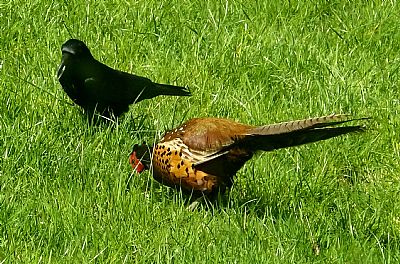
Companions by circumstance and a shared interest in fatball handouts; a carrion crow and a cock pheasant watch each other to see who has found some first. This can become competitive.
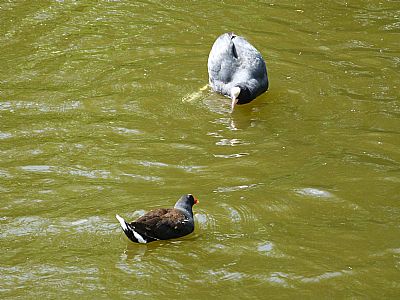
Getting good photographs "in the wild" can be exciting, but parks offer opportunities of getting closer to birds that have got used to people. This one was taken in Glasgow. A moorhen left and a coot right squabble over hand-outs. Use suitable water bird or general bird foods accordingly and avoid household foods such as bread as this can cause health issues.
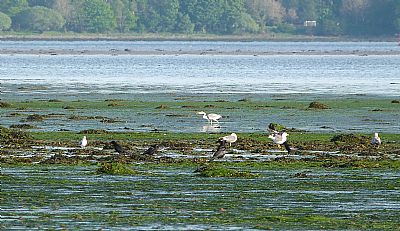
A great time to see a variety of water birds together. A warm evening in early spring with the tide way out on the Clyde. Swans, gulls, oyster catchers, herons, crows. All enjoying the banquet of accessible food. Crustaceans, molluscs, worms, fish trapped in pools.
The low tides can give us humans a sense of confidence. But it can turn surprisingly quickly. We do not have true quicksand here, but the mud can get you stuck if you are not careful, enough to hinder your safe return to the shore in time. Ever so often we hear of rescues out here. Don't let it be you. You are not a seabird.
ALL TRAILS birdwatching routes : https://www.alltrails.com/explore/scotland/argyll-and-bute/alexandria--2?b_tl_lat=56.02449826217688&b_tl_lng=-4.6471236477236175&b_br_lat=55.96828020692837&b_br_lng=-4.455000222065138&mobileMap=true&a[]=birding
BRITISH TRUST FOR ORNITHOLOGY : https://www.bto.org/understanding-birds/welcome-birdfacts
eBird website : https://ebird.org/region/GB-SCT-WDU
RSPB : https://www.rspb.org.uk/birds-and-wildlife/wildlife-guides/bird-a-z/goosander/
RSPB : An excellent identification website :http:// https://www.rspb.org.uk/birds-and-wildlife/wildlife-guides/bird-a-z/ducks-geese-and-swans/
The RSPB Bird Reserve at Loch Lomond is described here : https://www.rspb.org.uk/reserves-and-events/reserves-a-z/loch-lomond/
WEST DUNBARTONSHIRE COUNCIL : https://www.west-dunbarton.gov.uk/leisure-parks-events/parks-and-greenspaces/parks/dalmuir-park/dalmuir-park-restoration-project/common-bird-species/
WILDVALE : https://www.wildvale.co.uk/about-us.html
WOODLAND TRUST : The Woodland Trust website has some useful bird identity lists :http:// https://www.woodlandtrust.org.uk/visiting-woods/woods/lang-craigs/

